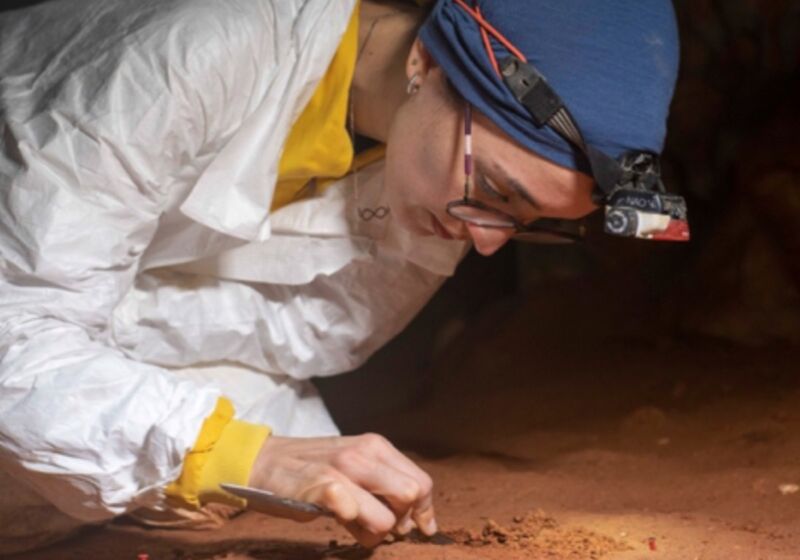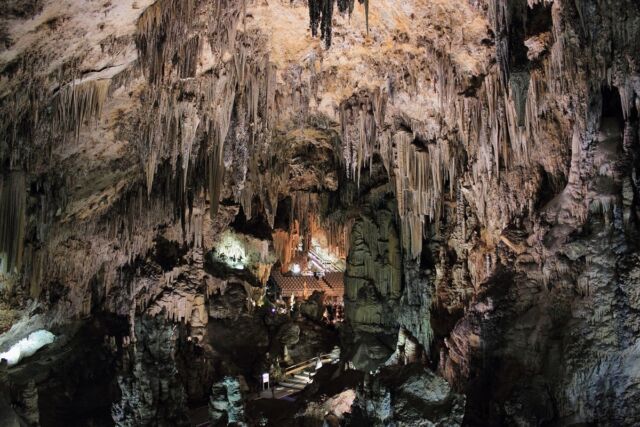
University of Cordoba
For over a decade, Maria Medina, an archaeologist affiliated with the University of Cordoba, has been conducting research on what she terms “smoke archaeology”: trying to reconstruct Europe’s prehistoric past by analyzing the remnants of torches, fire, and smoke in French and Spanish caves. Her latest discovery is that humans regularly visited the Caves of Nerja as far back as 41,000 years ago, a good 10,000 years earlier than previously believed, according to a recent paper published in the journal Scientific Reports.
As we’ve reported previously, there are nearly 350 prehistoric caves in France and Spain alone, and they include the oldest cave painting yet known: a red hand stencil in Maltravieso Cave in Caceres, Spain, likely drawn by a Neanderthal some 64,000 years ago. The Caves of Nerja are located in Malaga, Spain, and boast their own paintings believed to date back 42,000 years.
The caves were discovered in 1959 by a group of five friends who gained access via a narrow sinkhole dubbed “La Mina”—one of two natural entrances, with a third created the following year to enable better access for tourists.
There are two main parts to this subterranean structure. Nerja I includes Show Galleries that tourists can enter, while visitors are barred from Nerja II, which includes an Upper Gallery and a New Gallery, first discovered in 1969. Concerts and festivals are held in the Hall of the Waterfall or Ballet, with seating capacity for up to 100 people. Down one hall is the Organ Corner, so named because it has fluted columns that produce different musical notes when struck, and there’s some evidence that this may have been an intentional modification.

Archaeological excavations of the Nerja Caves over the decades have unearthed skeletal human remains dating back to around 25,000 BCE on, as well as animal bones, shells, fish bones, and stone and bone tools. Small groups of humans used the caves seasonally until 21,000 BCE, when they became a permanent residence. By 4500 BCE, it seems the caves were being used for farming and making pottery. Textiles were being made by 3800 BCE, with some parts of the cave being used for burial.
In 2012, Spanish archaeologists announced the discovery of two cave paintings of what appear to be seals, believed to be the oldest cave paintings yet found based on radiocarbon dating of charcoal remains found nearby. They are believed to be 42,300 to 43,500 years old. That’s significantly older than the 30,000-year-old Chauvet cave paintings in southeast France. It’s even possible that the seal paintings were created by Neanderthals since some scholars think they were still living in the south and west of the Iberian peninsula until some 37,000 years ago, although Homo sapiens might also have been in the region around that time.
Studying these caves using fire and smoke can tell researchers more about the customs and rituals of these prehistoric humans. For instance, in 2021, Medina and several colleagues conducted in situ experiments with three different kinds of Paleolithic lighting sources in the hopes of shedding some light (pun intended) on what those various illumination methods might tell us about the emergence of “human symbolic and artistic behavior” in the form of cave art. The Spanish team chose to conduct their experiments at the Isuntza 1 Cave in Spain’s Basque country. They chose lighting types based on known archaeological data: five torches, two stone lamps with animal fat, and a small fireplace.

Medina-Alcaide et al, 2021, PLOS ONE
Their measurements showed that the various lighting sources had very different characteristics and were thus probably used in different contexts. The wooden torches, for instance, emitted light in all directions, up to nearly six meters (19.6 feet), and lasted an average of 41 minutes. The torches exhibited uneven light intensity and often needed to be relit by waving them from side to side, and they produced a lot of smoke, so they worked best for exploring caves or crossing wide spaces.








